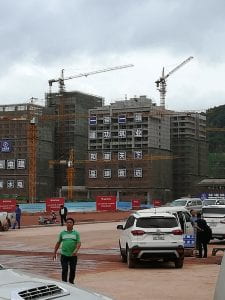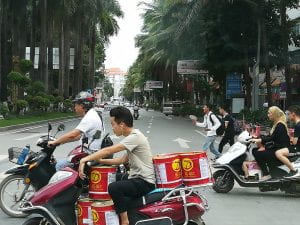When my husband and I first visited the Lao PDR briefly in December 2016, we learnt about China’s growing influence in the country. In Luangprabang province, my Lao friend told us that there were plans for a railroad from China going through Luangprabang, to be completed in the early part of the 2020s. We frowned at the idea of more Chinese people coming into Laos, perhaps reflecting the then-widespread suspicion over China’s growing influence.
Fast forward 2.5 years later, and I am in Luangprabang doing my fieldwork. During my first weekend here, I heard a few stories from a tour guide about how Chinese businessmen literally buy Lao women as their wives – some who are less willing than others. Hence, as a Singaporean of Chinese ethnicity, I found it more comfortable to identify myself as a Singaporean who happens to speak Chinese, rather than as a Chinese person from Singapore. I grew up in multi-racial, English-speaking Singapore, and while I’ve had my dose of education and exposure about Chinese culture, I am biophysically Southeast Asian (for example, I abhor cold weather). Having studied the struggles of nation-building in post-colonial Southeast Asia, I am also frequently irked by those of my parents’ generation who identify more with the Chinese diaspora community than with fellow Southeast Asians. What is Chineseness, anyway[i]?
So, when we travelled from Luang Prabang city to cross the Lao-Chinese border at Boten (in Laos) and Mohan (in China), I was quite guarded when interacting with fellow Chinese travellers on the bus, although many were, simply, Chinese construction workers going home for a visit. As we approached the border, we saw massive construction works as well as a part of the built Special Economic Zone. I think this will serve as the future interchange for the China-Lao railroad. There were lots of banners with Chinese and Lao words proclaiming how the Chinese and Lao people are building a common future together.

One Belt, One Road (一带一路) in Laos starts at Boten, where a Special Economic Zone on the Lao side of the China-Lao border is under construction

A completed section of the upcoming Special Economic Zone at Boten, on the Lao side of the Lao-China border
During our next two nights in China, I warmed up to interacting with Chinese people. Being fluent in the language definitely helps to get things done faster – although I still struggled with some Chinese vocabulary! We saw some shops selling rosewood and ironwood from Laos. According to some Chinese people we spoke to, whereas much of China’s land has been intensively used for urban development or for agriculture, Laos is seen as the ‘untouched hinterland’.

In Mohan (磨憨), the Chinese town at the Lao-China border. The sign at this shop says “Lao Ironwood Chopping Board”
Yet, I was still happy to return to Laos. Perhaps it was the relaxed feel of the country that enticed me, as compared to what seemed like the monetisation of Chinese life. (Or perhaps I just understand less of the Lao language, so I am ‘shut-off’ from an overload of information?) Compared to the Chinese immigration officer, the Lao immigration officer seemed more trusting of my Southeast Asian passport. ASEAN <3 <3!!!
In our group was one Lao citizen crossing the border into Laos. He seemed out of place at the Chinese immigration checkpoint, but after crossing the Lao checkpoint he looked a lot more relaxed. Yet, he was decked in what looked like newly-bought apparel from China, and he looked quite proud to be bringing his shopping home. While we waited for our bus at the Lao side of the border, he bought something from a Chinese man selling Lao SIM cards, and they conversed in the Lao language. Seeing them communicate was quite touching: one of the reasons why many Lao people view the Chinese with suspicion is because of the language barrier (learning Chinese is difficult), but here is an example of a Chinese man who, albeit for practical reasons, has mastered the language and is able to communicate with the Lao people.
On the bus, we conversed with some Chinese travellers. Several of them said that they were trying to explore new fortunes in Laos, because they found that living in China has become too competitive and cut-throat. During the lunch stopover at Oudomxay, they stayed in their own group. They somewhat reminded us of old stereotypes about American travellers – how they stay within their package tours and do things that resonate with their own culture. But I think this behaviour is quite human: cautious of interacting with people whose language they do not understand.
2019 is Visit Laos-China Year[ii], and it remains to be seen what impact increasing Chinese tourism will have for Luang Prabang, whose visitors have until now mainly comprise Europeans and South Koreans. Will the nature of tourism change to suit the preferences of Chinese tourists? For example, given that wildlife tourism in Thailand has evolved to suit Chinese tastes[iii], would wildlife tourism in Laos evolve likewise?
And what major changes will the railroad bring, once it is ready to ferry car-loads of Chinese travellers and businessmen through the mountains of northern Laos? There is a nascent concern about this, and it is reassuring to hear that there are forums being organised for SMEs to discuss how they can cope with increasing Chinese influence[iv].
For me, there is no more opportune time to leverage on my Chineseness. Some Lao people I’ve met already understand a little Chinese, but they have to also balance this with understanding English, Vietnamese, and even Korean – in addition to local ethnic languages such as Khmu and Hmong. Not easy! So I have started offering to practise Chinese with those who are interested. The more bridges we can help build through better communication, the less the risk of mutual misunderstanding and suspicion.
===========
[i] While some in the Chinese diaspora community hold on tightly to their Chinese cultural practices, I was introduced to ‘Chineseness’ as an identity concept when a group of students from NUS Chinese Studies shared about their research during a teaching workshop in mid-2018. For a more in-depth exploration of the concept, one can refer to publications such as Allen Chun (2017)’s ‘Forget Chineseness: On the Geopolitics of Cultural Identification’ (publisher: State University of New York, USA).
[ii] http://www.chinadaily.com.cn/a/201901/24/WS5c496905a3106c65c34e6538.html
[iii] https://www.nationalgeographic.com/magazine/2019/06/global-wildlife-tourism-social-media-causes-animal-suffering/
[iv] Personal communication, meeting with CDE Bern in Vientiane, 25 June 2019.







Leave a Reply